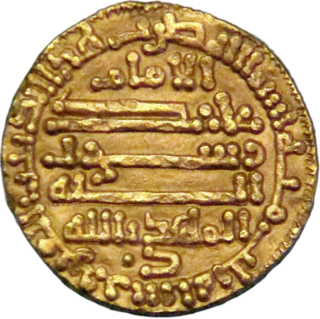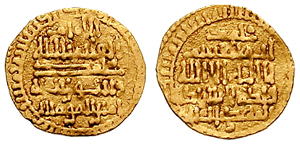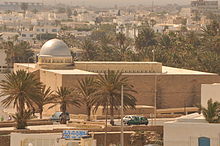
The Fatimid Caliphate was an Ismaili Shi'a caliphate extant from the tenth to the twelfth centuries AD. Spanning a large area of North Africa, it ranged from the Atlantic Ocean in the west to the Red Sea in the east. The Fatimids, a dynasty of Arab origin, trace their ancestry to Muhammad's daughter Fatima and her husband, ‘Ali b. Abi Talib, the first Shi‘a imam. The Fatimids were acknowledged as the rightful imams by different Isma‘ili communities as well as by denominations in many other Muslim lands and adjacent regions. Originating during the Abbasid Caliphate, the Fatimids conquered Ifriqiya and established the city of al-Mahdiyya. The Ismaili dynasty ruled territories across the Mediterranean coast of Africa and ultimately made Egypt the center of the caliphate. At its height, the caliphate included—in addition to Egypt—varying areas of the Maghreb, Sudan, Sicily, the Levant, and the Hijaz.
The Fatimid dynasty was an Isma'ili Shi'a dynasty of Arab descent that ruled an extensive empire, the Fatimid Caliphate, between 909 and 1171 CE. Claiming descent from Fatima and Ali, they also held the Isma'ili imamate, claiming to be the rightful leaders of the Muslim community. The line of Nizari Isma'ili imams, represented today by the Aga Khans, claims descent from a branch of the Fatimids. The Alavi Bohras, predominantly based in Vadodara (Baroda) also descend from the branch of the Fatimids.

Abū Muḥammad ʿAbd Allāh ibn al-Ḥusayn, better known by his regnal name al-Mahdī Billāh, was the founder of the Isma'ili Fatimid Caliphate, the only major Shi'a caliphate in Islamic history, and the eleventh Imam of the Isma'ili branch of Shi'ism.

Abū Yazīd Makhlad ibn Kaydād, also known as the Man on the Donkey, was an Ibadi Berber of the Banu Ifran tribe who led a rebellion against the Fatimid Caliphate in Ifriqiya starting in 944. Abu Yazid conquered Kairouan for a time, but was eventually driven back and defeated by the Fatimid caliph al-Mansur bi-Nasr Allah.

Abu al-Mansur Nizar, known by his regnal name as al-Aziz Billah, was the fifth caliph of the Fatimid dynasty, from 975 to his death in 996. His reign saw the capture of Damascus and the Fatimid expansion into the Levant, which brought al-Aziz into conflict with the Byzantine emperor Basil II over control of Aleppo. During the course of this expansion, al-Aziz took into his service large numbers of Turkic and Daylamite slave-soldiers, thereby breaking the near-monopoly on Fatimid military power held until then by the Kutama Berbers.

Abu Tahir Isma'il, better known by his regnal name al-Mansur Billah, was the third caliph of the Fatimid Caliphate in Ifriqiya, ruling from 946 until his death. He presided over a period of crisis, having to confront the large-scale Kharijite rebellion of Abu Yazid. He succeeded in suppressing the revolt and restoring the stability of the Fatimid regime.

Abū al-Qāsim Muḥammad ibn ʿAbd Allāh, better known by his regnal name al-Qāʾim (القائم) or al-Qāʾim bi-Amr Allāh, was the second caliph of the Fatimid dynasty, ruling in Ifriqiya from 934 to 946. He was the twelfth Isma'ili Imam, succeeding his father Abd Allah al-Mahdi Billah.
Hafizi Isma'ilism was a branch of Musta'li Isma'ilism that emerged as a result of a split in 1132. The Hafizis accepted the Fatimid caliph Abd al-Majid al-Hafiz li-Din Allah and his successors as imams, while the rival Tayyibi branch rejected them as usurpers, favouring the succession of the imamate along the line of al-Hafiz's nephew, al-Tayyib.
Abū Ḥanīfa al-Nuʿmān ibn Muḥammad ibn Manṣūr ibn Aḥmad ibn Ḥayyūn al-Tamīmiyy (Arabic: النعمان بن محمد بن منصور بن أحمد بن حيون التميمي, generally known as al-Qāḍī al-Nu‘mān or as ibn Ḥayyūn was an Isma'ili jurist and the official historian of the Fatimid Caliphate. He was also called Qaḍi al-Quḍāt "Jurist of the Jurists" and Dāʻī al-Duʻāt "Missionary of Missionaries".

The navy of the Fatimid Caliphate was one of the most developed early Muslim navies and a major military force in the central and eastern Mediterranean in the 10th–12th centuries. As with the dynasty it served, its history can be distinguished into two phases. The first period, from c. 909 to 969, when the Fatimids were based in Ifriqiya, and the second period, lasting until the end of the dynasty in 1171, when the Fatimids were based in Egypt. During the first period, the navy was employed mainly in the constant warfare with the Byzantine Empire in Sicily and southern Italy, where the Fatimids enjoyed mixed success, as well as in the initially unsuccessful attempts to conquer Egypt from the Abbasids and the brief clashes with the Umayyad Caliphate of Córdoba.
Al-Hasan ibn Ali ibn Abi al-Husayn al-Kalbi, known in Byzantine sources as Boulchasenes and Aboulchare (Ἀβουλχαρέ), was the first Kalbid Emir of Sicily. A member of an aristocratic family within the ruling circle of the Fatimid Caliphate, he helped suppress the great revolt of Abu Yazid in 943–947 and was sent as governor of Sicily from 948 until 953, when he returned to Ifriqiya. He was succeeded in Sicily by his son Ahmad ibn al-Hasan al-Kalbi, but led several campaigns in Sicily and southern Italy against the Byzantines in 955–958, as well as the raid against Almeria that sparked a brief conflict with the Caliphate of Córdoba in 955. He died at Palermo in 964, during another campaign against the Byzantines.
ʿAmmar ibn ʿAlī ibn Abī al-Ḥusayn al-Kalbī was a member of the Kalbid family and a military commander for the Fatimid Caliphate in its wars with the Byzantine Empire in Sicily and southern Italy in the 950s.
Abū'l-Futūh Barjawān al-Ustādh was a eunuch palace official who became the prime minister (wāsiṭa) and de facto regent of the Shia Fatimid Caliphate in October 997, and held the position until his assassination. Of obscure origin, Barjawan became the tutor of heir-apparent al-Hakim bi-Amr Allah, who became caliph in 996 with the death of al-Aziz Billah. On al-Hakim's coronation, power was seized by the Kutama Berbers, who tried to monopolize government and clashed with their rivals, the Turkic slave-soldiers. Allied with disaffected Berber leaders, Barjawan was able to seize the reins of government for himself in 997. His tenure was marked by a successful balancing act between the Berbers and the Turks, as well as the rise of men of diverse backgrounds, promoted under his patronage. Militarily, Barjawan was successful in restoring order to the Fatimids' restive Levantine and Libyan provinces, and set the stage for an enduring truce with the Byzantine Empire. The concentration of power in his hands and his overbearing attitude alienated al-Hakim, however, who ordered him assassinated and thereafter assumed the governance of the caliphate himself.
The first Fatimid invasion of Egypt occurred in 914–915, soon after the establishment of the Fatimid Caliphate in Ifriqiya in 909. The Fatimids launched an expedition east, against the Abbasid Caliphate, under the Berber General Habasa ibn Yusuf. Habasa succeeded in subduing the cities on the Libyan coast between Ifriqiya and Egypt, and captured Alexandria. The Fatimid heir-apparent, al-Qa'im bi-Amr Allah, then arrived to take over the campaign. Attempts to conquer the Egyptian capital, Fustat, were beaten back by the Abbasid troops in the province. A risky affair even at the outset, the arrival of Abbasid reinforcements from Syria and Iraq under Mu'nis al-Muzaffar doomed the invasion to failure, and al-Qa'im and the remnants of his army abandoned Alexandria and returned to Ifriqiya in May 915. The failure did not prevent the Fatimids from launching another unsuccessful attempt to capture Egypt four years later. It was not until 969 that the Fatimids conquered Egypt and made it the centre of their empire.
The second Fatimid invasion of Egypt occurred in 919–921, following the failure of the first attempt in 914–915. The expedition was again commanded by the Fatimid Caliphate's heir-apparent, al-Qa'im bi-Amr Allah. As during the previous attempt, the Fatimids captured Alexandria with ease. However, while the Abbasid garrison in Fustat was weaker and mutinous due to lack of pay, al-Qa'im did not exploit it for an immediate attack on the city, such as the one that had failed in 914. Instead, in March 920 the Fatimid navy was destroyed by the Abbasid fleet under Thamal al-Dulafi, and Abbasid reinforcements under Mu'nis al-Muzaffar arrived at Fustat. Nevertheless, in the summer of 920 al-Qa'im was able to capture the Fayyum Oasis, and in the spring of 921 extend his control over much of Upper Egypt as well, while Mu'nis avoided an open confrontation and remained at Fustat. During that time, both sides were engaged in a diplomatic and propaganda battle, with the Fatimids' in particular trying to sway the Muslim populace on their side, without success. The Fatimid expedition was condemned to failure when Thamal's fleet took Alexandria in May/June 921; when the Abbasid forces moved on Fayyum, al-Qa'im was forced to abandon it and flee west over the desert.
The Fatimid conquest of Egypt took place in 969, as the troops of the Fatimid Caliphate under the general Jawhar captured Egypt, then ruled by the autonomous Ikhshidid dynasty in the name of the Abbasid Caliphate.
Ahmad ibn Ziyadat Allah ibn Qurhub, commonly known simply as Ibn Qurhub, ruled Sicily in rebellion against the Fatimid Caliphate, from 913 to 916. He launched raids against the Byzantine Empire in southern Italy and against the shores of Fatimid Ifriqiya, but was deposed and handed over to the Fatimids, who executed him and his followers in July 916.
Khalil ibn Ishaq al-Tamimi was an Arab military commander, in the service of the Fatimid Caliphate as head of the Arab jund of Ifriqiya. He was active as early as 913. From 937 to 941 he was the governor of Sicily, leading the brutal suppression of a large-scale anti-Fatimid revolt. He was captured and killed in 944, during the anti-Fatimid rebellion of Abu Yazid.
Abu'l-Qāsim al-Ḥasan ibn Faraj ibn Ḥawshab ibn Zādān al-Najjār al-Kūfī, better known simply as Ibn Ḥawshab, or by his honorific of Manṣūr al-Yaman, was a senior Isma'ili missionary from the environs of Kufa. In cooperation with Ali ibn al-Fadl al-Jayshani, he established the Isma'ili creed in Yemen and conquered much of that country in the 890s and 900s in the name of the Isma'ili imam, Abdallah al-Mahdi, who at the time was still in hiding. After al-Mahdi proclaimed himself publicly in Ifriqiya in 909 and established the Fatimid Caliphate, Ibn al-Fadl turned against him and forced Ibn Hawshab to a subordinate position. Ibn Hawshab's life is known from an autobiography he wrote, while later Isma'ili tradition ascribes two theological treatises to him.
Ja'far ibn Mansur al-Yaman was an Isma'ili missionary and theological writer of the 10th century. Originally born and raised in Yemen, where his father Ibn Hawshab had established the Isma'ili daʿwa in the late 9th century, he fled the country to the court of the Fatimid caliphs in Ifriqiya, where he remained until his death. He composed poems in praise of the Fatimids' victory over the uprising of Abu Yazid, a biography of his father, and authored or compiled a number of important theological treatises.








